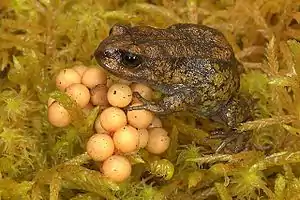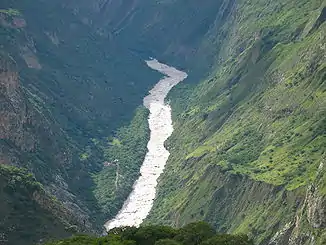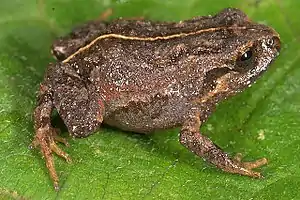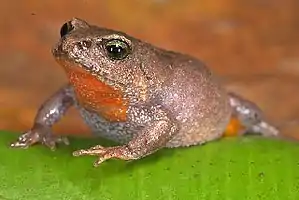Bryophryne
Bryophryne ist eine Gattung der Froschlurche aus der Familie Strabomantidae. Die Gattung wurde 2008 aufgestellt, als die Gattung Phrynopus aufgrund molekulargenetischer Untersuchungen in mehrere Gattungen aufgeteilt werden musste. Typusart der Gattung ist Bryophryne cophites, ehemals Phrynopus cophites.[1] Alle Arten dieser Froschgattung sind im Süden Perus beheimatet.
| Bryophryne | ||||||||||||
|---|---|---|---|---|---|---|---|---|---|---|---|---|

Bryophryne cophites im Moos mit Eiern | ||||||||||||
| Systematik | ||||||||||||
| ||||||||||||
| Wissenschaftlicher Name | ||||||||||||
| Bryophryne | ||||||||||||
| Hedges, Duellman & Heinicke, 2008 |

Merkmale
Charakteristisch für die Gattung ist ein schmaler Kopf, der nie so breit wie der Körper wird. Sechs der bisher beschriebenen Arten besitzen keine Tympanalmembran, auch die entsprechende Vertiefung (Cavum tympanicum) in den Schädelknochen dieser Region fehlt, ebenso die Columella (Gehörknöchelchen).[2] Die Männchen der meisten Arten haben auch keine Stimmritzen und keine Schallblasen.[3]
Der erste Finger ist kürzer als der zweite, die dritte und fünfte Zehe sind gleich lang. Die Kopf-Rumpf-Länge beträgt bis maximal 29,3 Millimeter, es handelt sich also um sehr kleine Frösche. Ihre Färbung besteht aus verschiedenen Brauntönen.
Verbreitung und Lebensraum
Die Gattung ist in den Nebelwäldern der peruanischen Andenregion verbreitet. Sie kommt in der Cordillera Oriental in der Provinz Cusco in Höhen zwischen 2900 und 4120 Metern vor. Ab 4000 Metern Seehöhe wird der Nebelwald von der Graslandschaft der Puna abgelöst. Geographisch ist das Verbreitungsgebiet der Gattung Bryophryne von jenem der verwandten Gattung Phrynopus, die ebenfalls in Peru beheimatet ist, durch das tief eingeschnittene Tal des Río Apurímac getrennt.[4]
Lebensweise
Die Gattung Bryophryne gehört zu der Gruppe der Terrarana, das sind süd- und mittelamerikanische Frösche, die eine direkte Entwicklung an Land ohne ein Kaulquappenstadium im Wasser durchlaufen. Die Entwicklung bis hin zum fertigen Jungfrosch findet innerhalb des Eis statt.[1]
Arten
Neben der Typusart Bryophryne cophites und der 2007 entdeckten Art Bryophryne bustamantei,[5] die ursprünglich beide zur Gattung Phrynopus gezählt wurden, gibt es zwölf weitere, in den vergangenen Jahren neu entdeckte Arten.
- Bryophryne abramalagae Lehr & Catenazzi, 2010[2]
- Bryophryne bakersfield Chaparro, Padial, Gutiérrez & De la Riva, 2015[6]
- Bryophryne bustamantei (Chaparro, De la Riva, Padial, Ochoa & Lehr, 2007)[5]
- Bryophryne cophites (Lynch, 1975)
- Bryophryne flammiventris Lehr & Catenazzi, 2010[2]
- Bryophryne gymnotis Lehr & Catenazzi, 2009[3]
- Bryophryne hanssaueri Lehr & Catenazzi, 2009[3]
- Bryophryne mancoinca Mamani, Catenazzi, Ttito & Chaparro, 2017[7]
- Bryophryne nubilosus Lehr & Catenazzi, 2008[4]
- Bryophryne phuyuhampatu Catenazzi, Ttito, Diaz & Shepack, 2017[8]
- Bryophryne quellokunka De la Riva, Chaparro, Castroviejo-Fisher & Padial, 2017[9]
- Bryophryne tocra De La Riva, Chaparro, Castroviejo-Fisher & Padial, 2017[9]
- Bryophryne wilakunka De La Riva, Chaparro, Castroviejo-Fisher & Padial, 2017[9]
- Bryophryne zonalis Lehr & Catenazzi, 2009[3]
(Stand: 4. Januar 2018)
 Bryophryne bustamantei
Bryophryne bustamantei Bryophryne gymnotis
Bryophryne gymnotis Bryophryne hanssaueri
Bryophryne hanssaueri Bryophryne nubilosus
Bryophryne nubilosus Bryophryne zonalis
Bryophryne zonalis
Einzelnachweise
- S. Blair Hedges, William E. Duellman, Matthew P. Heinicke: New World direct-developing frogs (Anura: Terrarana): molecular phylogeny, classification, biogeography, and conservation. Zootaxa 1737, S. 1–182, 2008
- Edgar Lehr & Alessandro Catenazzi: Two New Species of Bryophryne (Anura: Strabomantidae) from High Elevations in Southern Peru (Region of Cusco). Herpetologica, 66, 3, S. 308–319, 2010 doi:10.1655/09-038.1
- Edgar Lehr & Alessandro Catenazzi: Three New Species of Bryophryne (Anura: Strabomantidae) from the Region of Cusco, Peru. South American Journal of Herpetology, 4, 2, S. 125–138, 2009 doi:10.2994/057.004.0204
- Edgar Lehr & Alessandro Catenazzi: A New Species of Bryophryne (Anura: Strabomantidae) from Southern Peru. Zootaxa 1784, S. 1–10, 2008
- Juan C. Chaparro, Ignacio De La Riva, José M. Padial, J. A. Ochoa & Edgar Lehr: A new species of Phrynopus from Departamento Cusco, southern Peru (Anura: Brachycephalidae). Zootaxa, 1618, S. 61–68, 2007
- Juan C. Chaparro, José M. Padial, Roberto C. Gutiérrez & Ignacio De la Riva: A new species of Andean frog of the genus Bryophryne from southern Peru (Anura: Craugastoridae) and its phylogenetic position, with notes on the diversity of the genus. Zootaxa, 3994, 1, S. 94–108, Juli 2015 doi:10.11646/zootaxa.3994.1.4
- L. Mamani, A. Catenazzi, A. Ttito, J. C. Chaparro: A new species of Bryophryne (Anura: Strabomantidae) from the Cordillera de Vilcabamba, southeastern Peruvian Andes. Phyllomedusa 16, S. 129–141, 2017
- Alessandro Catenazzi, A. Ttito, M. I. Diaz & A. Shepack: Bryophryne phuyuhampatu sp. n., a new species of Cusco Andes frog from the cloud forest of the eastern slopes of the Peruvian Andes (Amphibia, Anura, Craugastoridae). ZooKeys, 685, S. 65–81
- Ignacio De La Riva, Juan C. Chaparro, S. Castroviejo-Fisher & José M. Padial: Underestimated anuran radiations in the high Andes: five new species and a new genus of Holoadeninae, and their phylogenetic relationships (Anura: Craugastoridae). Zoological Journal of the Linnean Society, 40, S. 1–44, 2017
Literatur
- S. Blair Hedges, William E. Duellman, Matthew P. Heinicke: New World direct-developing frogs (Anura: Terrarana): Molecular phylogeny, classification, biogeography, and conservation. Zootaxa 1737, S. 1–182, 2008 ISBN 978-1-86977-197-3 (Erstbeschreibung, S. 99)
Weblinks
- Darrel R. Frost: Bryophryne Hedges, Duellman, and Heinicke, 2008, Amphibian Species of the World, Version 6.0, an Online Reference, Electronic Database accessible at American Museum of Natural History, New York 1998–2015, abgerufen am 15. Juni 2015 (englisch)
- Bryophryne cophites bei ARKive (Bilder) (Memento vom 6. Februar 2019 im Internet Archive).
- Bryophryne bustamantei bei ARKive (Bilder) (Memento vom 6. Februar 2019 im Internet Archive).